|






BPE 2018 Bamako
MALI
Tel. +223 20217140
Fax: +223 20217140


| |
Info about the sites
-
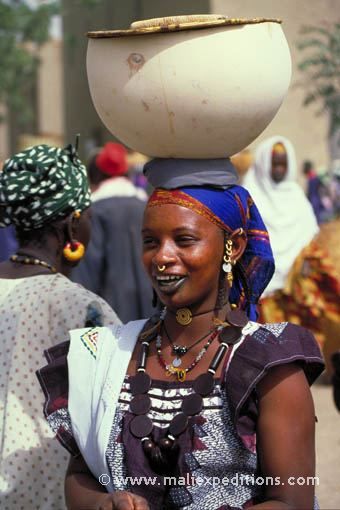 Why
Mali ? Why
Mali ?
Located between the Sahara in the north and the sahel plains in the
south, Mali is the cradle of West African empires and hence of West
African culture. The country called today Mali is son of medieval
Empires and Kingdoms: Empire of Ghana, Kingdom of Sosso, Kingdom of
Mandingo which became Empire of Mali in the 14th century, The Songhoi
Empire, the Bambara Kingdom of Segou, The Senoufo Kingdom of Kenedougou
The Toucouleur Empire of El Hadj Omar Tall ,The Fulani Kingdom of
Macina, and the wassoulou Empire of Almamy Samory Touré This diversity
of Empires and Kingdoms make this piece of land very riche in culture
and traditions.
In fact the Foundator of Mali Empire SOUNDIATA KEITA gave the country
the name Mali in 1235 on Kurukan Fughan in Kangaba .After his glorious
victory upon the sorcerer Soumangourou Kanté, he said the strongest and
biggest animal on earth and in water is Hippopotamus which is MALI in
local language, since our land is the strongest and the biggest one in
the area ,we give the name Mali to our country.
-
GEOGRAPHY
The Republic of Mali, 6 times the size of the UK, is West Africa’s
largest country covering an area of 1,241,000 sq kms.
Formerly called “Bilad es-Sudan” that is “land of Blacks”, Mali lies in
the heart of West Africa, at the crossroads of the gulf of Guinea, North
Africa .
Stretching approximately, 1,500 km north to south and 1,800 km east to
west, Mali borders with 7 countries: Senegal, Mauritania, Algeria,
Niger, Burkina Faso, Ivory Coast and Guinea.
Broadly speaking had it not been for some “geological accidents” which
have given origin to some mountain ranges, this despite remaining a lad
of great geographical variations can be divided into 2 main sections :
The hilly-mountains areas in the peripheral regions : Kaarta and
Bambouk plateaux (400-600 m), and Mandingo Mt (400-800 m) in the south
west ; Kenedougou Massif (600-800 m.) and Bandiagara Plateau (200-500
m.) in the South ; Gandamia Massif (1080 m) and several isolated
inselbergs in the north-east ; Adrar des Ifoghas, linked to the Algerian
Hoggar, in the north(east. The country’s highest point is Mt Hombori
(1.155 mt) in the north-east.
The vast central plains where several natural regions can be
identified.
The sudaneze zone in the south, continuation of the Guinea forests ;
The Sahelian strip where savannah still tries to fight desertification ;
The central Delta of the Niger ;
The Saharan northern regions, gateway to the real desert.
Major topographical features are the Niger and the Senegal. The two main
rivers of west Africa and theirs tributaries. It is only the central and
southern regions of the country, which are irrigated by the two life
giving rivers. The vast northern area being exposed to the fast
encroaching desert.
The Senegal river (1.720 km) is made up of the Bafing and Bakoy rivers
which merge at Bafoulabé and rise respectively from Fouta-Djalon and the
north west plateau of Siguiri.
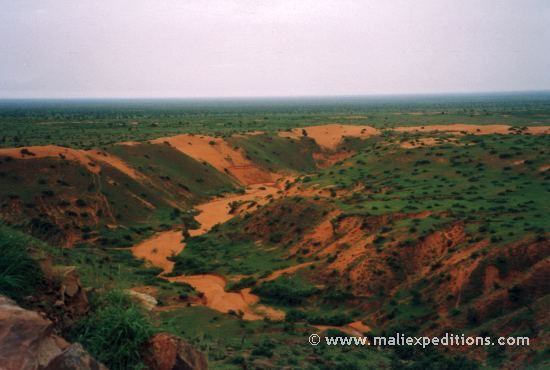
The Niger River, whose source is in Guinea, is 4.200 km long and flows
across Mali along 1,700 km giving origin to what is known as the Inland
Delta. In its upper course “the River of rivers” is also known as
Djoliba.
The terrain is predominately savannah and sand-covered plains ; 65 %
being desert or semi desert. The River flows through the heart of Mali
flowding annually and creating pasture land for livestock for six months
a year. It is precisely the Niger’s amazing size and scope (20,000 sq.km
of water in Mali alone) that in part gave the country its reputation as
“The granary of West Africa” during colonial times. But despite the
potential for irrigation on a colossal scale, population browth, drought
and desertification. Mostly caused by goats nibbling away the nation’s
groundcover – have made the lives of Mali’s farmers even harder.
-
POPULATION AND PEOPLES
Mali has an estimated 11 millions inhabitants. The majority live in
rural areas, 80 % of them relying on the land for their livelihood
(rain-fed agriculture on small landholdings). Quite a few raise
livestock and some earn their living from fishing.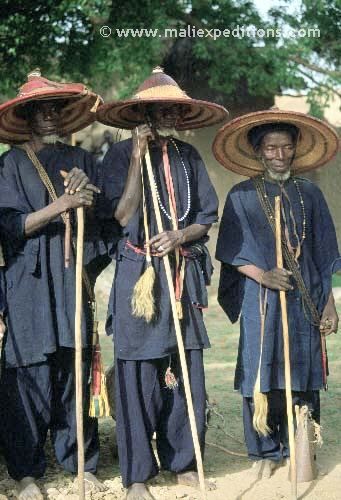
Mali’s population includes at least 23 ethnic groups – 73 % sedentary
and 27 % nomadic – from pastoralists and fisherman to rural farmers and
town dwellers. The main ethnic groups are:
BAMBARA. The largest ethnic group in the country (30%), they are centred
mostly around Ségou and Bamako. Mainly farmers, they are also excellent
craftsmen. Their language is well spoken through West Africa.
MALINKE: Quite a homogeneous group of uncertain origins, centred around
Bamako. Mainly farmers and followers of animism.
SARAKOLE or SONINKE: Originating from the ancient empire of Ghana, they
mostly inhabit the north-west frontier. Excellent traders and craftsmen.
SONGHAI: Powerful in the past, they centre in the inner delta region and
are agriculturalists.
BOZO: Occupying the central part of the Delta, they have the monopoly of
fishing between Djenné and lake Debo.
PEULH or FULANI : Cattle raising nomads originating from north east,
they wander between Tibesti and Adrar, Fouta Djalon and Adamaoura.
Making one of the main tribes in Sub Sahara Africa, they base their
economy on livestock (cattle and zebu).
TUAREG: Also known as “the blue men of the Sahara” they roam about the
desert in searching water for their livestock. Proud of their Berber
ancestors, they have always fought the “Black peoples”. Nowadays a few
have had to abandon their nomadic life in favour of a sedentary life.
DOGON: Living along the 250 km long Bandiagara Escarpment which has been
listed by UNESCO as a world heritage Site. There is an estimated
population of 250.000
Such cultural and ethnological richness, readily available to travellers,
is certainly one of the main reasons for wanting to visit Mali.
-
HISTORY
Mali, like many African Countries has not known early writing, this is
the main reason why Oral Tradition is of great importance in our
Society. Mali, inherited of old Kingdoms and Empires, started being
known in the 8th century under the reign of the Saracolle King Kaya
Maghan Cisse. He was the King of the Empire of Ghana called by oral
traditionalists Empire of Ouagadou.This Empire occupied the North-East
part of Mali. This Empire which capital city was Koumbi Saleh Is located
on the territory of Mauritania. It collapsed in the 11th century.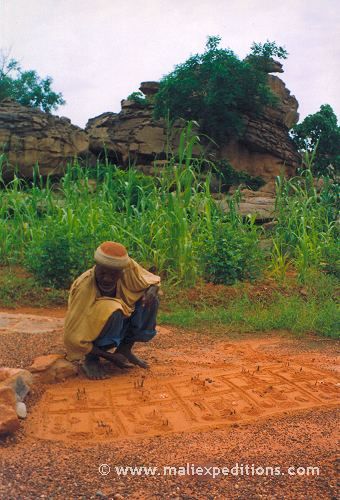
After the decline of the Ghana Empire all the small Kingdoms under his
control were independent: among which the Kingdom of Sosso, led by the
sorcerer King Soumangourou Kanté. This king was named sorcerer because
he was a shape changer. He could transform himself into 63 different
things on the field of battle to escape from his enemies. He was
defeated in 13th century by the foundator, the legendary Soundiata Keita
King of Mandingo Kingdom in 1235 in Kirina ,a small historical Malinké
village.
After his glorious victory on Soumangourou ,he summoned all the allied
Kings to a general meeting in Kurukan fuga in Kangaba the capital city,
of Mandingo. In this assembly ,he said “as our country is now the
biggest and the strongest Kingdom in the area, we can change its name.
The biggest and strongest animal in water and on earth is MALI (hippopotamous
in Malinké dialect), so let’s give the name Mali to our country, and the
Empire of Mali was born. He reigned over the Empire until 1255 AD when
he died drown in the Sankarani River. After him ,his first son Mamadi ,Mansa
Oulen or Mansa Jurulenko came to the throne .He kept the Empire big and
strong. He died in 1270AD leaving the Empire to Aboubakari I who reigned
over the Empire up to 1285at his death.He was replaced by Aboubakari II
whose ambition was to make the Empire wider. According to AL-Omari and
Ibn Battuta , he wanted to see the limit of the Ocean. He made two
hundred ships and sent them to to the Atlantic Ocean ,to discover what
is beyond it; unfortunately only one of them came back. He prepared
another two hundred ships and with himself they went and never came
back.
Serious studies have been done at the beginning of the years 80’s to
know the Emperor has reached the American Continent two centuries before
the European explorer Christopher Colombus or died on the way,which
remained without any proven result But, some South American names are
strangely Malinké words and expressions:
Eg: Guatemala=Middle of compound (in Malinké Dialect)
Nicaragua =Salut of the soul
Family name Camara in Brazilia and in Mali
Keith in USA and Keita in Mandingo
In 1312, seeing that the Emperor is not coming back, Kankan Moussa,
Kankou Moussa or Mansa Moussa came to the throne . In 1324, he did his
legendary pilgrimage to Mecca. He brought so much gold with him that the
precious metal lost its value for ten years. On his way back to Mali ,he
built the famous Mosque Djinguerayber in Tombouctou. He died in
1332,year that marked the decline of the Mali Empire.
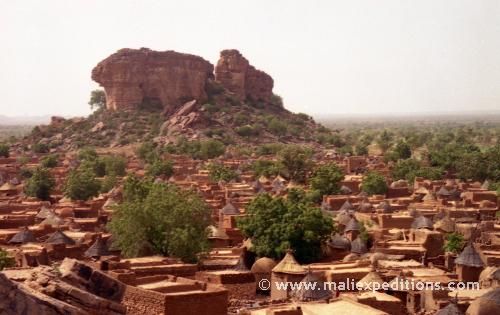
This end gave opportunity to Songhai Empire to become prosperous with
Sonny Ali Ber, an animist King who was not appreciated by Moslems. He
got drown and was succeeded by his son Sonny Baro who was hilled by
Moslems after few months of reign. It was now the time of Askia Mohamed
who was Moslem. He extended the Empire .He became blind in 1528, he
chose his cousin for succession. This choice made Askia Moussa
unhappy,then assassinated him and became Emperor who was also killed at
his turn by his brothers and cousins. Askia Mohamed II came to the
throne and made the Old Askia Mohamed exiled in Niger.
This action made Askia Ismael very angry ,killed him and became King. He
reigned for two years. In 1539 the Askia dynasty was defeated by the
Morrocan invaders.
That marked the end of the medieval kingdoms and Empires.
-
PRECOLONIAL KINGDOMS AND EMPIRES
After the medieval Kingdoms and Empires ,Mali has seen the creation of
some resistances such as Bambara kingdom of Segou, in the 18th century,
Toucouleur Empire of El Hadj OmarTall ,the Fulani Kingdom of Macina.
In the 19th century ,the Kenedougou Kingdom was created led by
MansaDaoula, then by Tičba Traoré and finally by Babemba Traore who
preferred committing suicide than being French prisoner. Kenedougou
Empire was taken by the French people in May 1898.TheFrench attacked the
Empire of wassoulou led by Almamy Samory Touré .He made resistance for
18 years ,then was arrested in September 29th 1898 in his Camp in
Guelemou ,deported in Gabon ,he died in 1900,which marked the end of
precolonial resistance.
After defeating all Kingdoms and Empires ,the French settled in Kayes,
1st administrative Region of Mali. Then they came to Bamako on February
1st 1883. One week later they started building the fort of
Bamako,followed by the creation of some institutions which goes with
development. In 1885 they arrived in Segou, and by the end of the years
80’s all Mali was occupied . It was in 1960 September 22nd that Mali got
her Independence, and the 1st elected President was Modibo Keita (1960-
1968)
He created many national companies .He had a socialist option. In 1968
in November He has been arrested by Lieutenant Moussa Traoré. All the
political parties disappeared because of CMLN(COMITEMILTAIRE DE
LIBRERATION NATIONALE) In 1979 he created UDPM.
In 1980 the scholars created an association led by Abdoul Karim Camara
Cabral to defend the students’ rights and improve their living
conditions. He was arrested and assassinated during one their
manifestations.
The situation will be quiet till 1990 when two political parties were
created :ADEMA AND CNID. Living conditions becoming tougher and tougher,
the salaries were too low and even not easy to get it.. Multipartism
became song of everyday .Finally a general revolution was organized.
Friday March 22nd 1991 all the population led by the students decided to
walk to the Presidential Palace. The President ordered the soldiers to
stop them by all means. With guns and other war weapons ,they were
shooting ,killing many people. But being descendants of kings and
Emperors people didn’t stop. They were breaking and burning everything
belonging to Moussa and his family down. Finally March 26th of the same
year Lieutenant Colonel Amadou Toumani Toure arrested Moussa Traore. and
led the transition for 14 months. Then Organized democratic election
which brought Alpha Omar Konare To the throne in 1992 then in was
reelected in 1997 for a second term. In 2002 Amadou Toumani Toure was
elected President of Mali.
  
|
